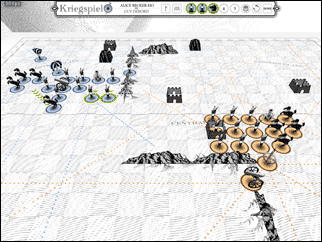Mano-a-Mano (or Womano)
 Yesterday, Alexander Galloway of NYU came to the UCI campus to discuss famed French situationist, tactical media progenitor, and author of The Society of the Spectacle Guy Debord and his foray into game design during the nineteen-seventies. Fortunately, Debord's book about his rarely played strategy-based board game, which he co-authored with his wife, Alice Becker Ho, is in print and recently translated into English. You can download and play an online version of Debord's game, renamed and redesigned by Galloway's team as "Kriegspiel" here.
Yesterday, Alexander Galloway of NYU came to the UCI campus to discuss famed French situationist, tactical media progenitor, and author of The Society of the Spectacle Guy Debord and his foray into game design during the nineteen-seventies. Fortunately, Debord's book about his rarely played strategy-based board game, which he co-authored with his wife, Alice Becker Ho, is in print and recently translated into English. You can download and play an online version of Debord's game, renamed and redesigned by Galloway's team as "Kriegspiel" here.Unfortunately, as Galloway explained to the audience, he had recently received a lawyer's letter regarding possible infringement of the rightful owner's intellectual property. Despite Galloway's insistence that an "idea for a game" or its "rules" are "not subject to copyright," those pursuing cease-and-desist orders against the makers of the Scrabulous application for Facebook might disagree.
Galloway opened his talk by looking at progressive movements of the nineteen-sixties and how, by the time that Debord was prototyping his "game of war" in the nineteen-seventies, radical groups like the Red Brigades had advanced to political kidnapping and assasination. (Among the images Galloway showed to the audience was the body of slain politician Aldo Moro in the back of a Renault R4.) Yet, in a time of asymmetrical conflicts, Debord created a game that was "abrasively anachronistic." Of course, Debord was familiar with contemporary games that modeled multilateral rather than bilateral relations, such as Djambi, which he played himself, which features both reporters and assassins. As Galloway pointed out, games with totalitarian goals could still represent the struggles of advanced liberal democracies.
Debord formed his own game company in an attempt to mass produce the game, the Society for Strategic or Historical Games, although only a few art editions were created in metal. (See above for Galloway facing off against McKenzie Wark.) Yet the game seemed closer to representing the work of Prussian military thinker Carl von Clausewitz than the "rhizomatic distributed networks" with which Debord is often associated, and as a manifestation of the game theories involved in military engagement it isn't even capable of the crafty improvisations and psychological engagement that characterize Sun Tzu. Although the design of the game emphasizes sleek unornamented and abstract modernism, the battlefield scenarios seem inspired by Napoleon without the information design insights, as mapped by Minard, that Edward Tufte has associated with the French leader's retreat.
Galloway pointed out that the seeming symmetry between North and South is actually more complicated than it initially appears, however, and that the role that pieces that serve as "reflector units" that control "lines of communication" play in the strategy of the game points to the importance of networked interactions.
I'm looking forward to checking out Galloway's "massively two-player" version of the game online, particularly since its open source architecture and Java Monkey Engine will allow others to skin the game and create interesting mods.

Update: There's more from McKenzie Wark about this story here.
Labels: copyright, game politics, information theory, military, talks, UC Irvine

0 Comments:
Post a Comment
<< Home